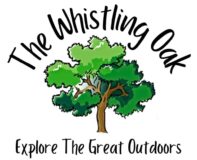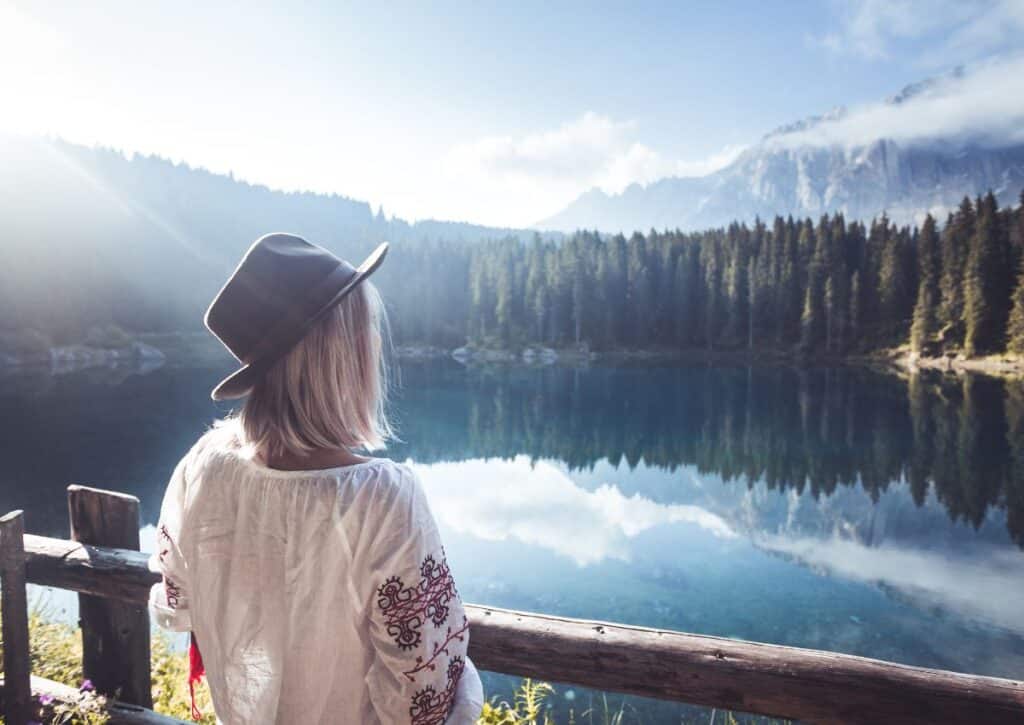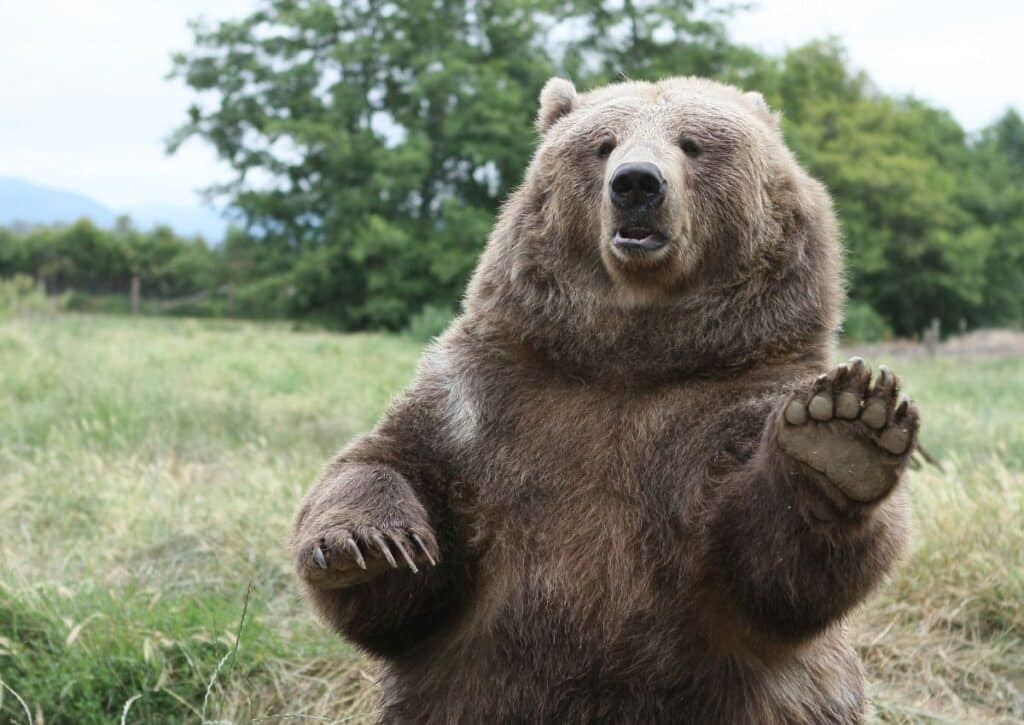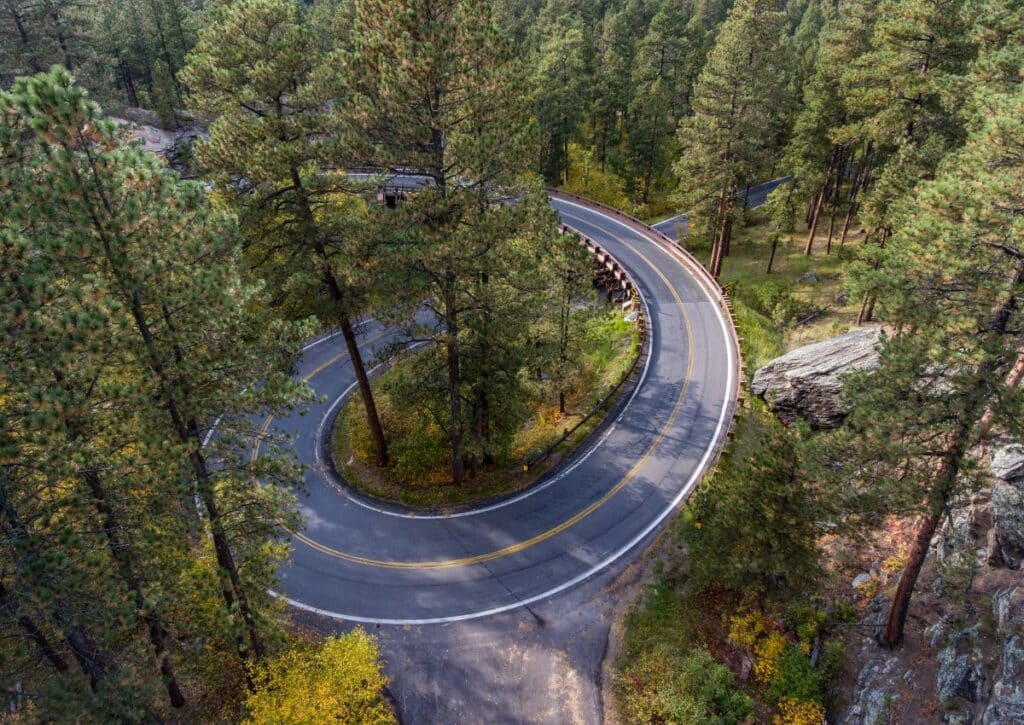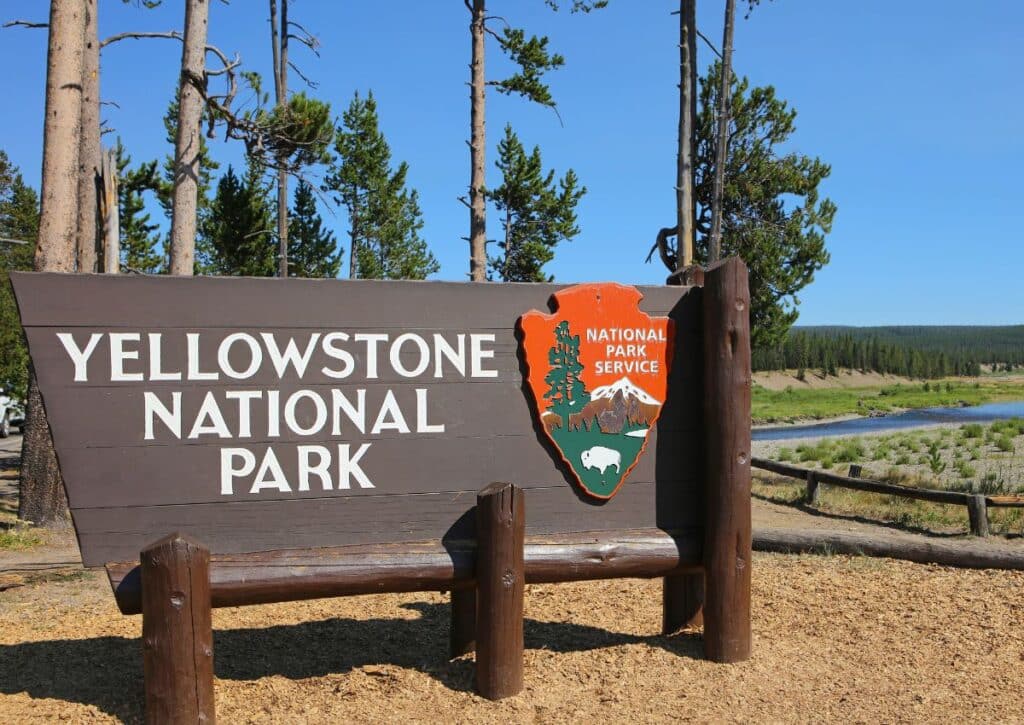Explore the lakes in Yellowstone, including our unforgettable hike to Delusion Lake. Nature's secrets await.
You know, when you first think of Yellowstone, the geysers and vast landscapes might come to mind. But the lakes in Yellowstone? We were just as curious as you, wondering which lakes would give us those ‘stop and stare’ moments.
So, we strapped on our hiking boots and set out as explorers eager for stories to share around campfires.
What we found was that each lake had its own personality. Some were quiet, giving us space to think, while others felt like bustling hubs of nature, with birds chatting and waters playing their age-old tunes.
So, grab your favorite beverage, get comfy, and join us on this journey through Yellowstone’s lesser-talked-about gems. Who knows? Maybe you’ll find the lake that calls out to you.
Delusion Lake
Delusion Lake, located within the magnificent expanse of Yellowstone National Park, is a hidden gem awaiting the nature enthusiast. It is alos our favorite lake in Yellowstone due to it being ignored by most visitors.
We’ve experienced this to be a wildlife haven – a watering hole for wildlife that avoids tourit crowds at Yellowstone Lake.
Origin of the Name
The lake was christened ‘Delusion’ by early explorers who mistakenly believed it was an extension of Yellowstone Lake. However, Delusion Lake stands as its own entity, spanning approximately 0.4 miles in width and 2.4 miles in length.
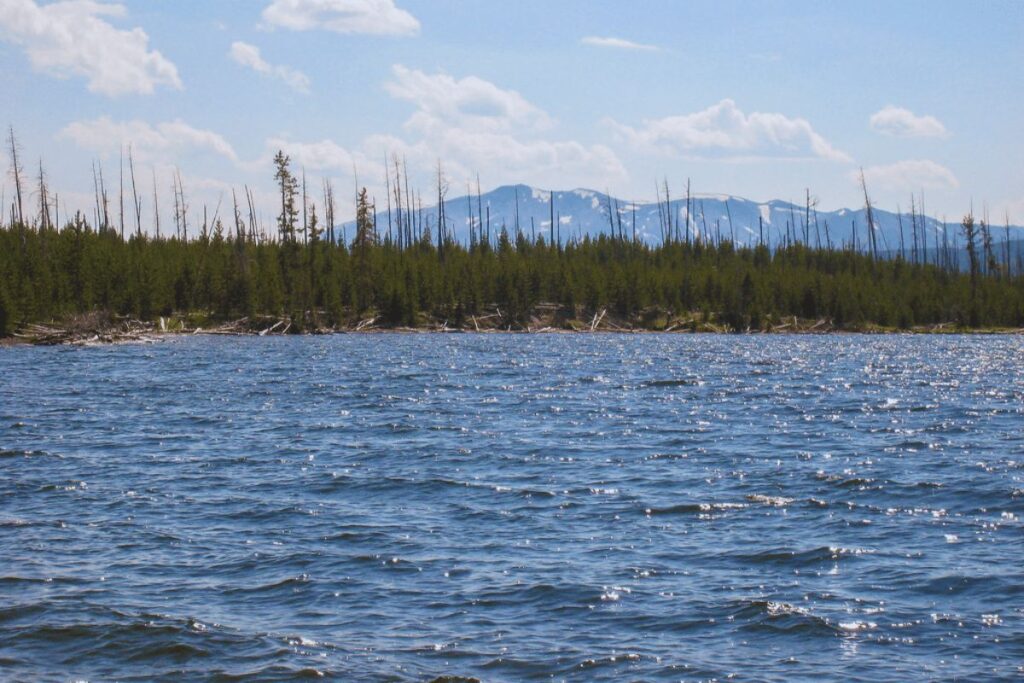
The Hike to Delusion Lake
Starting Point: Riddle Lake Trailhead.
Route: Begin with a two-mile trek down the Riddle Lake Trail that leads to Riddle Lake. From here, find the lake’s outlet and trace the meadows alongside Solution Creek for about 3.6 miles.
This trail will take you through some bushwhacking amid burns until you reach another stretch of meadows leading straight to Delusion Lake.
On the return, you’ll traverse a burned area for about a mile, reconnect with Solution Creek, and follow it to Yellowstone Lake.
You can then trace the lake’s shoreline back to Grant Village or take the road by the water treatment plant to return to the campground.
Terrain and Trail Features: The trail offers a blend of established paths and off-trail sections.
Landmarks include the meadows along the Riddle Lake Trail, a swan nesting spot by the Riddle Lake outlet, the dry terrains of Solution Creek, and the old burns leading to Delusion Lake.
Watch out for the uneven grounds of the marshy meadows marked on maps which, interestingly, turn out to be quite dry.
Distance: An estimated 15 miles round trip, accounting for some minor deviations and exploratory detours.
Key Highlights: Lush meadows, spectacular views of Mount Sheridan, lily pad-covered lakes, and a final breathtaking reveal of Delusion Lake.
Wildlife Encounters
Nature and animal lovers will have a treat, with potential sightings.
Birds’ Serenade: From the graceful trumpeter swans taking residence by Riddle Lake to the dance of the sandhill cranes in nearby meadows, birdwatchers are in for a treat.
High above, hawks cut across the sky, while the sight of a majestic bald eagle by Yellowstone Lake can be awe-inspiring.
Not to forget, the Canadian geese and playful ducks that dot the water’s surface.
Majestic Mammals: While traversing the trails, you might spot a magnificent moose, usually around water bodies.
The graceful elks, with their signature antlers, might make an appearance, often accompanied by the delicate deer frolicking in the grasslands.
Bear Sightings: As you venture deeper into the woods, remember you’re in bear country. Both grizzly and black bears have been spotted around Delusion Lake.
Always be cautious, maintain a safe distance, and adhere to guidelines when in their territory.
During your visit, revel in the natural beauty and cherish these wildlife encounters, while always ensuring to minimize your impact and respect their space.
Camping and Accommodation
Camping:
Yellowstone National Park – Bridge Bay: A picturesque spot to camp near Delusion Lake.
Yellowstone National Park – Grant Village: Another favored camping location, also the endpoint of the hike described above.
Lodging:
Togwotee Mountain Lodge: A recommended place to stay for those looking for comfort and amenities.
Seasonal Conditions
Summer:
Daytime temperatures soar to the 70s.
Nighttime temperatures can dip to the 40s.
Winter:
Daytime highs hover around the 20s.
Nighttime temperatures can plummet to the 0s.
Before embarking on a trip, always check the weather conditions and prepare accordingly.
Delusion Lake offers a serene environment for those seeking solitude and a genuine connection with nature.
Whether you’re hiking, observing wildlife, or simply capturing the beauty with your camera, this location promises an unforgettable experience.
Remember to respect nature, leave no trace, and enjoy the pristine beauty of Delusion Lake.
Yellowstone Lake
Yellowstone Lake stands as a testament to nature’s grandeur. Holding the title of the largest natural freshwater lake in the U.S., this body of water is more than just a sight to behold.
Located at an impressive elevation of 7,733 feet, it’s also the largest high-altitude lake in North America. Spanning approximately 20 miles in length and 14 miles in width, its vastness encompasses a surface area of 132 square miles, caressed by 141 miles of shoreline.
Amidst the expansive Greater Yellowstone Ecosystem, the lake serves as both a haven for wildlife and an escape for those seeking tranquility and awe.
Flora and Fauna
The lush surroundings of Yellowstone Lake paint a vivid landscape. From dense forests dominated by lodgepole pine and Douglas fir to expansive grasslands and sagebrush, nature thrives here.
The shoreline is a mosaic of wetlands, marshes, and mudflats. It’s not just the landscapes that captivate; the lake is a sanctuary for birdlife.
Bald eagles, ospreys, grebes, loons, and geese are frequent visitors, with countless waterbirds choosing to winter here during their migratory journeys.
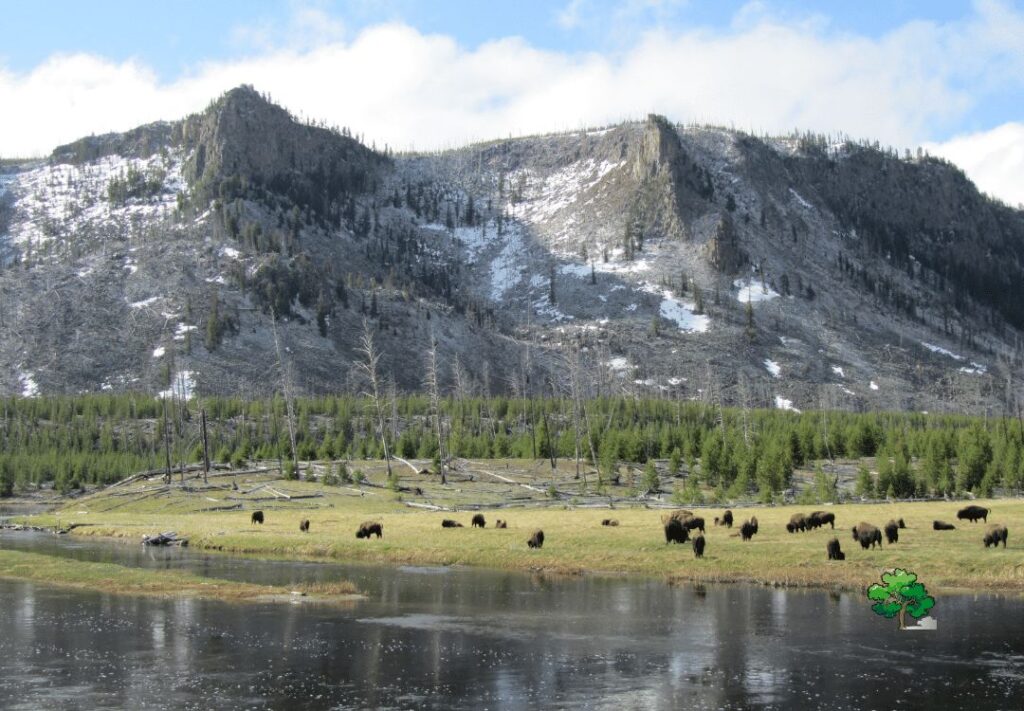
Hiking Trails & Adventures
For those drawn to the allure of the trail, Yellowstone Lake doesn’t disappoint. The Storm Point Trail, a gentle 2.3-mile loop, meanders through enchanting meadows and dense pine forests, leading adventurers straight to the lake.
Taking roughly 1-2 hours to complete, it’s an excursion that offers serenity with every step. For those seeking a bit more challenge, the Elephant Back Mountain Trail beckons.
A climb that requires effort but pays off with unmatched views of Yellowstone Lake, and a unique feature – an array of geothermal wonders visible during the journey.
Mysteries and Wonders of the Lake
One of the lake’s many wonders is its freezing pattern. Each winter, usually between late December and early January, the lake transforms into an icy marvel.
It then thaws by late May or early June, but remains a cold entity year-round, with average temperatures hovering around 41°F. Its chilling waters, though mesmerizing, are not recommended for swimming.
Fishermen, however, have a unique draw to these waters. The lake is home to North America’s largest wild cutthroat trout population.
The origins of these Pacific Ocean fish, now in a lake that drains to the Atlantic, are a tale of geographical wonders.
The prevailing belief is that Yellowstone Lake once had connections to the Pacific via the Snake River, allowing fish to traverse the Continental Divide at Two Ocean Pass.
Today, the lake drains from its sole outlet, the Yellowstone River, at Fishing Bridge.
Grebe Lake
Grebe Lake is a shimmering expanse covering 156 acres. It’s not just any lake; it’s a haven for anglers and nature enthusiasts alike.
Renowned for its pristine waters, Grebe Lake is also a headwater for the Gibbon River. But it’s not just the azure waters that make this lake special; its unique population of Arctic grayling, with their distinct large dorsal fins, is a sight to behold and a treat for anglers.
The lake’s proximity, just a mere 3.1 miles north of the Norris-Canyon stretch, makes it accessible yet secluded.
Hiking to Grebe Lake
On the trail to Grebe Lake, you’ll be embraced by dense Lodgepole Pine forests, punctuated by sprawling meadows. The 3-mile trek, mostly flat and amiable, starts from a trailhead located between Norris and Canyon.
While the journey is generally smooth, the trail might present muddy patches early in the season.
An added thrill: the region does see some bear activity. Hence, always advisable to hike in groups and keep bear spray handy.
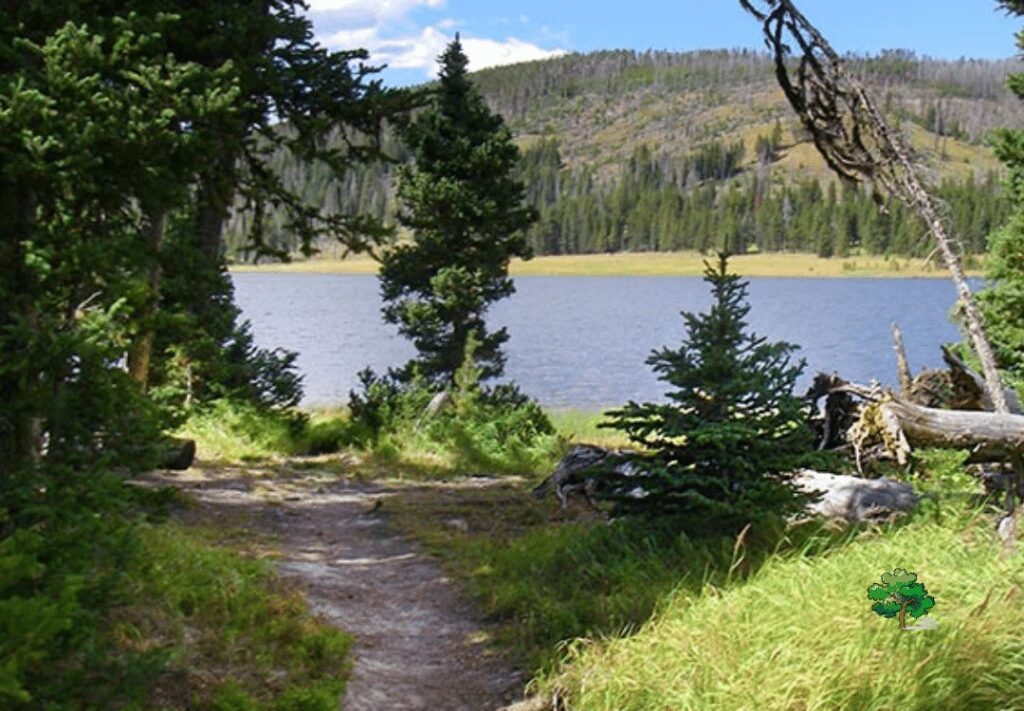
Wildlife & Fishing
Grebe Lake’s claim to fame extends to its rich aquatic life. Introduced in 1921, the Arctic grayling has since flourished in these waters.
Conservation efforts have been pivotal in maintaining a balance, notably the 2017 initiative to counteract non-native species.
Anglers, gear up! Early season, especially June, offers prime fishing opportunities. Whether you’re keen on subsurface fishing with the likes of Wooly Buggers or fancy some dry fly action as the summer rolls, Grebe Lake has it all.
For those inclined, a float tube can offer access to the deeper, more elusive parts of the lake. Do note, a park service boating permit is necessary.
Camping Around Grebe Lake
Nature lovers, Grebe Lake is your canvas! With four backcountry campsites strewn around the lake, it’s an invitation for an unparalleled wilderness experience. Bask in the tranquil ambiance, with the gentle lapping of the lake waters and the whispering pines setting the mood.
Grebe Lake, with its tranquil beauty and vibrant ecosystem, is a treasure trove in Yellowstone National Park.
Whether you’re an angler, hiker, or someone seeking solace in nature, Grebe Lake beckons with open arms.
Every visit promises a new story, a new memory, and a rejuvenated spirit. Don’t miss out on this enchanting escapade!
Shoshone Lake
Yellowstone’s second largest lake, Shoshone, sits proudly at the head of the Lewis River. Throughout the years, it has donned various names, each echoing stories of explorers and the indigenous Shoshone tribe.
The lake’s current name, rooted in the Snake River’s original Indian name, honors those who might have visited its shores each summer.
The Shoshones’ rich heritage is embedded in the very meaning of their name – “those who camp together in wickiups” or “grass house people.”
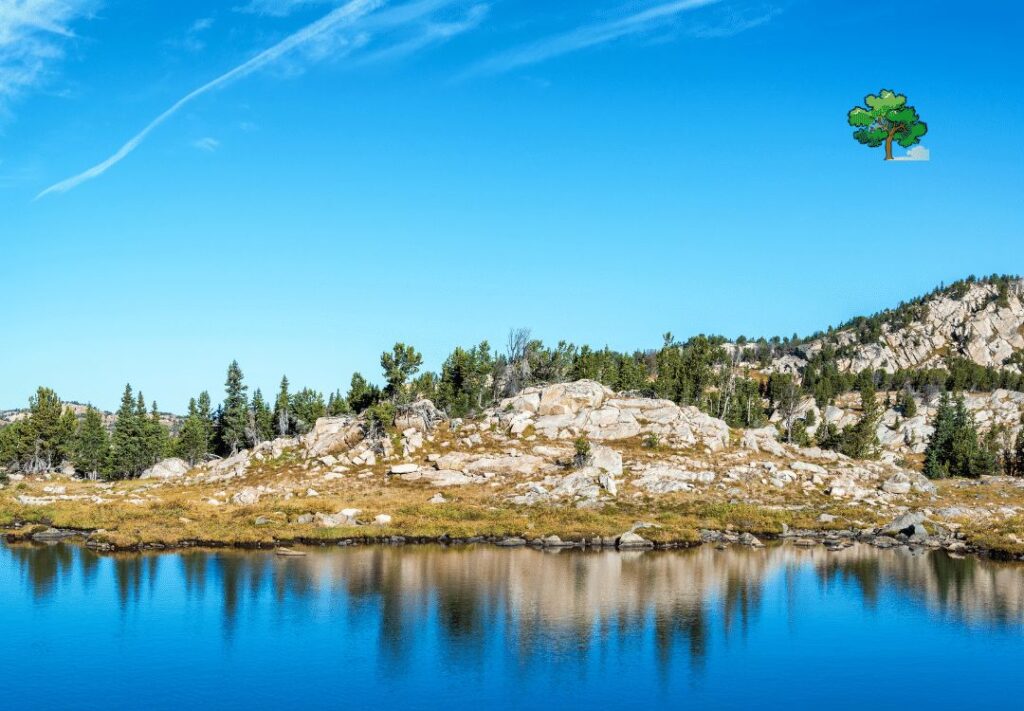
The depth of Shoshone reaches an impressive 205 feet, covering an area of 8,050 acres. It stands out as a unique aquatic marvel.
Possibly the largest lake in the contiguous U.S. inaccessible by road, Shoshone remains untamed, a silent reminder of a world less explored.
Navigating the Trails: Journeying to Shoshone
Lone Star Geyser Trail: This 10-mile trail beginning from Old Faithful leads adventurers through the captivating Lone Star Geyser, eventually reaching Shoshone Lake. It’s best undertaken as an overnight journey.
DeLacy Creek Trail: This is the quickest route to the lake, offering a comfortable 6-mile round-trip journey. The trailhead starts 8.8 miles west of West Thumb.
Lewis River Trail: Starting just north of Lewis Lake, this trail covers 11 miles in total. Wanderers can follow the Lewis Channel to Shoshone Lake, making it a memorable loop journey.
For those water-bound adventurers, kayaking or canoeing from Lewis Lake up the Lewis Channel promises an unforgettable experience.
It’s a multi-day adventure best taken with a guide. However, be sure to have permits in order for any water vessel.
Shoshone’s Bountiful Nature & Activities
Upon reaching the lake, the real adventure begins. Fishermen will find the lake teeming with trout, making it a haven in June and July.
The vastness of the lake offers ample opportunity for canoeing or kayaking, for those looking to explore further.
But it’s not all about the water. On the lake’s western edge, the Shoshone Geyser Basin beckons with its array of geysers and hot springs.
Without any boardwalks, this place feels untouched, raw, and genuine. However, caution is advised.
Camping under the Stars
Shoshone Lake offers several backcountry camping spots for those who wish to linger and absorb its tranquility.
Securing a backcountry camping permit is essential before setting off. The lake’s surrounding beauty is best experienced in the warmth of summer or the gentle embrace of early fall.
For the more adventurous, winter trails accessible by cross-country skis from Old Faithful are available, though it’s quite the trek.
Trailhead: DeLacy Creek Trailhead
The hike to Shoshone Lake, the park’s largest backcountry lake, is a 6-mile round trip journey of moderate difficulty.
The trail follows DeLacy Creek before opening out onto the shores of the Lake, and typically takes about 3-4 hours to complete.
The Dogshead Trail offers an alternate, longer route.
The unique feature of this trail is the chance to see the lake’s geyser basin, one of only a few in the world that’s situated along a lakeshore.
Isa Lake
Isa Lake is a unique hydrological marvel. Situated atop the Continental Divide at Craig Pass, this small lake holds a secret that belies its size.
Before the area became a hub for explorers and tourists, it was home to indigenous communities for thousands of years. By the 1800s, the Nimíipuu, Absaroke, and Shoshone Nations were prominent residents.
Hiram M. Chittenden, in 1891, discovered the lake while mapping routes between key Yellowstone landmarks. He named it after Miss Isabel Jelke of Cincinnati, though the reason remains a mystery.
Two Oceans, One Lake – The secret
What sets Isa Lake apart is its rare drainage system. While it’s common for lakes to drain into one ocean, Isa Lake defies the norm. Its eastern side flows toward the Pacific Ocean via the Lewis River, while the west side heads towards the Gulf of Mexico through the Firehole River.
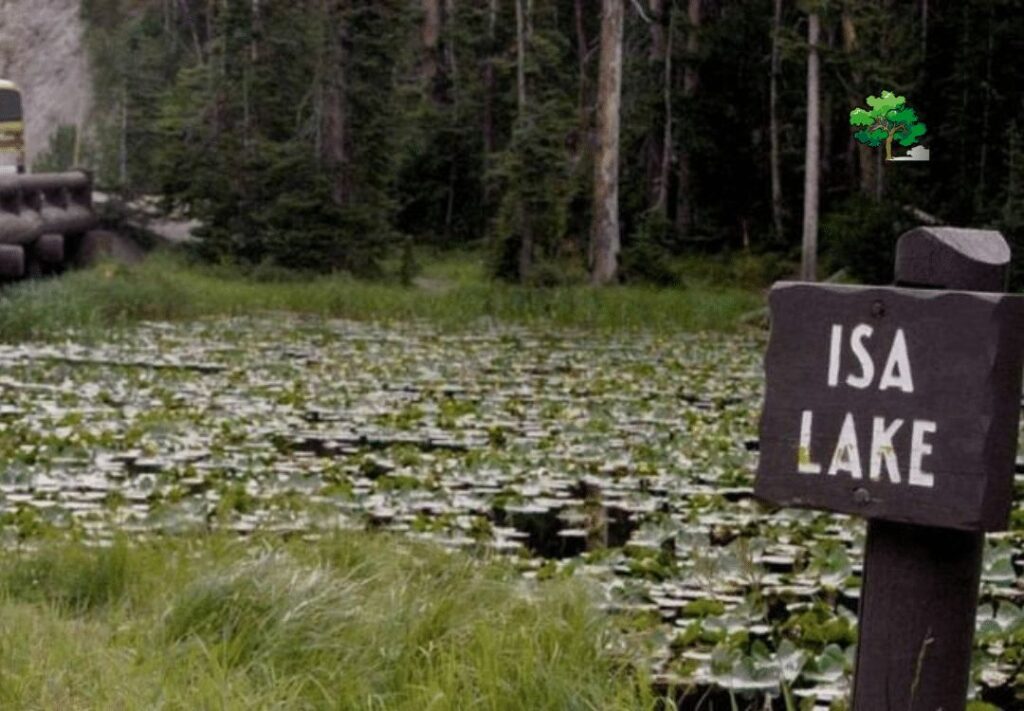
Visitors keen on seeing this wonder can find it along the road linking the Old Faithful and West Thumb geyser basins, a popular route in Yellowstone.
And for those wishing to linger, the area is adorned with the vibrant yellow pond-lily, making the lake a serene stopover.
Trailhead: Isa Lake Picnic Area
Located on the Continental Divide, Isa Lake is known for its quirky geographical feature – it drains backward!
The easy, less than a mile long trail, takes about 20-30 minutes to walk and it’s a delightful short journey for families and casual hikers.
An alternate trail, the Kepler Cascades trail, offers a longer hike with a beautiful waterfall.
The standout feature of this trail is the lake itself, which interestingly drains into both the Atlantic and Pacific Oceans.
Camping Near Isa Lake
For adventurers looking to immerse themselves in the Yellowstone experience, camping is a must.
Several campgrounds are available nearby, offering a mix of amenities and wilderness experiences.
Whether you’re setting up a tent or parking an RV, the region provides an unforgettable backdrop to your stay.
The Continental Divide’s Quirk
Yellowstone’s Continental Divide isn’t a straightforward ridge. Travelers might cross it multiple times in a single journey through the park.
Craig Pass, at 8,262 feet, is the loftiest of these crossings.
Here, Isa Lake showcases its unique drainage behavior, most noticeable after the snow melts in the spring.
Trout Lake
Nestled in the expansive Lamar Valley in Yellowstone’s northeast corner, Trout Lake is a serene haven that promises both beauty and adventure.
While this corner of the park is already renowned for its wildlife sightings, Trout Lake offers its own unique charms and surprises.
Setting Out
The starting point for this journey is clearly marked by a spacious pullout and a sign pointing towards Trout Lake.
A word to the eager traveler, though: this spot is a favorite among fishers, so a solitary experience isn’t guaranteed.
The trail kicks off with an invigorating ascent up a hill. It might test your calves and get your heart pumping, but it’s a short climb.
The reward? A breathtaking view of the calm, mirror-like Trout Lake reflecting the grandeur of the surrounding mountains.
Taking the Scenic Route
Why merely climb a hill when you can circle a lake? The flat trail encircling Trout Lake is both accessible and delightful.
Many, including myself, choose the rightward path around the lake, which adds a bit more distance but significantly enhances the experience.
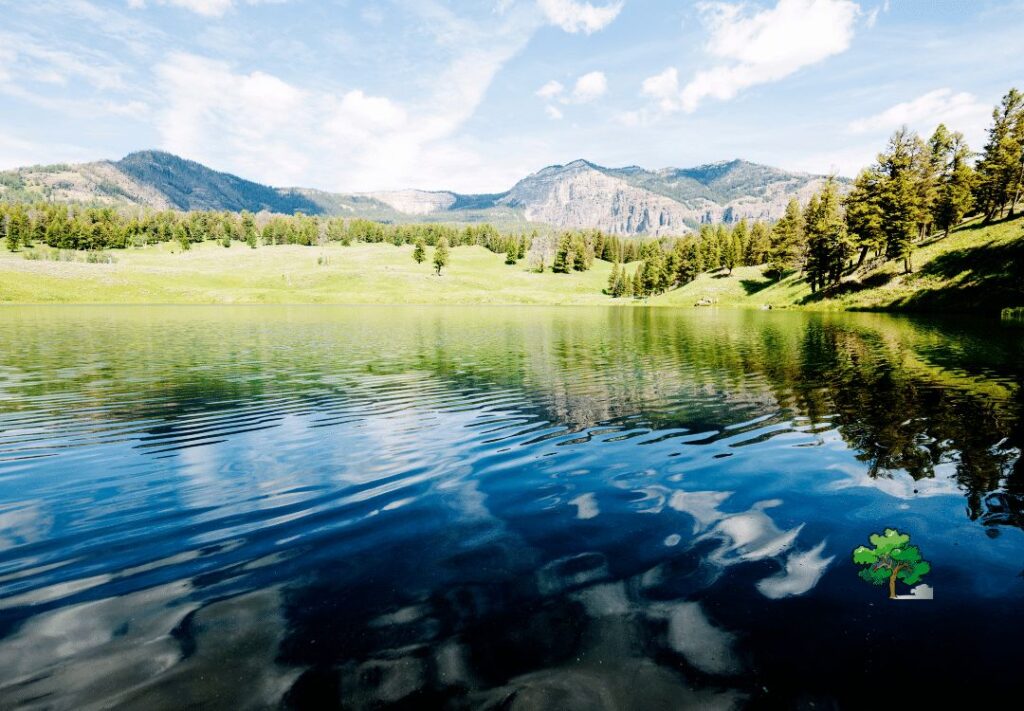
Trail Essentials
Views: Expect captivating lake vistas, vibrant wildflowers, and potential wildlife encounters.
Trailhead: Located approximately 1.5 miles south of Pebble Creek Campground on the Northeast Entrance Road.
Distance: A manageable 1.3-mile round trip.
Elevation: Starts at 6,755 feet, peaks at 6,970 feet.
Difficulty: Easy. However, the initial climb might feel moderately strenuous for some.
Coordinates: Latitude 44.89918, Longitude -110.12315.
Nature’s Bounty and Surprises
While the trail to and around Trout Lake is a spectacle in itself, nature often throws in a few surprises.
On a fortunate day, you might spot bison grazing by the Soda Butte Creek valley or witness an otter gliding through the lake.
Fishing enthusiasts will also appreciate the lake’s abundant offerings.
A noteworthy detour is the trail leading up to a vantage point overlooking the valley and mountains.
But a word of caution – the area’s bison residents might not always appreciate the company. A respectful distance ensures a safe and harmonious coexistence.
Spring’s Special Gift
For those visiting during the late spring or early summer, nature offers a floral treat.
The trail bursts into a riot of colors, with wildflowers blooming in abundance, making it a photographer’s dream.
Safety First
While the serene surroundings might be entrancing, it’s essential to be aware of potential bear activity in the region.
Always take precautions, and consider returning via the same path you took.
Trailhead: Trout Lake Trailhead
This short but steep 1.2-mile round-trip trail leads you to the beautiful Trout Lake. It typically takes hikers around 1 hour to complete this hike.
An alternate trail, the Buckhorn Trail, offers a more challenging journey through the park’s backcountry.
The trail’s unique feature is the lake’s outlet stream, a popular spot to observe otters and spawning cutthroat trout in early summer.
Heart Lake
Heart Lake is located in the northeast section of the park and is a popular destination for hikers and campers.
Heart Lake is about 6 miles (10 kilometers) from the road that leads to it, so it can be reached by car or by hiking. The trailhead begins at the end of Heart Lake Road, which begins at Canyon Village on U.S. Highway 89 (the Grand Loop Road).
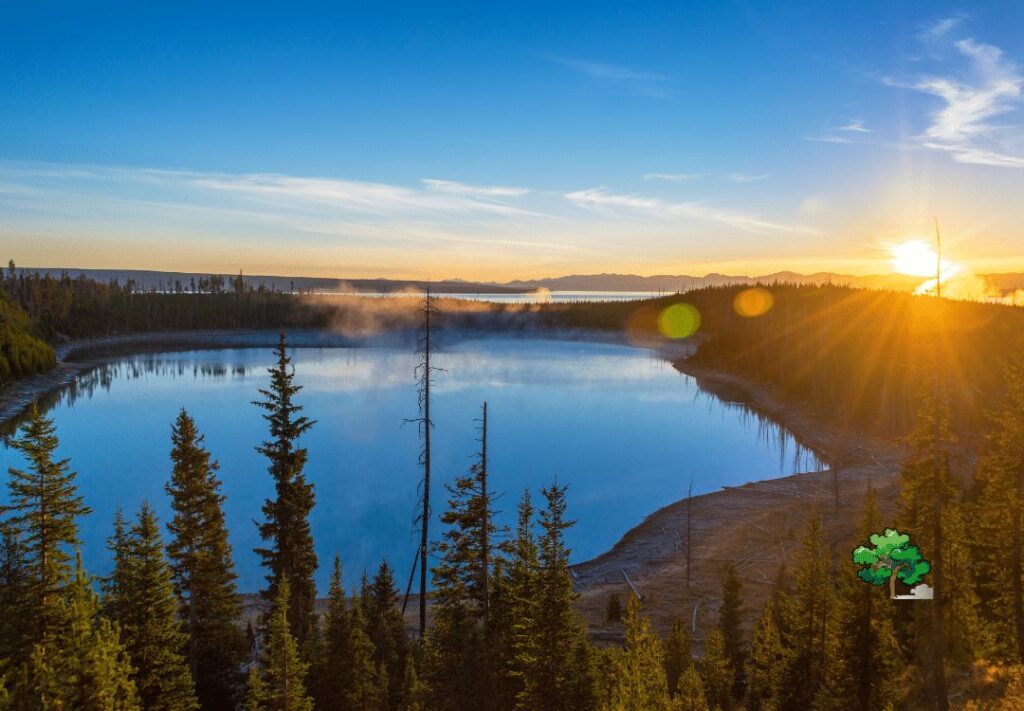
Amidst the serenity of Mount Sheridan in the southern region of Yellowstone, Heart Lake stands as a testament to untouched nature.
Flanked by the continental divide and overlooking Yellowstone Lake, it offers a secluded escape in one of Yellowstone’s most pristine areas.
With minimal man-made structures, it offers an unspoiled view of nature’s grandeur, making it a preferred choice for hikers and backpackers.
Trailhead
The Heart Lake trailhead is conveniently located near the park’s southern entrance off West Thumb Rd. Though secluded, the lake’s allure often draws adventurers willing to undertake the day-long hike or horse ride to its shores.
Sitting at an elevation of 7,461 feet, the journey promises thin air and breathtaking views. There are multiple routes to Heart Lake, including the Trail Creek trail and the Heart River trail/Snake River trail.
Historical Tidbits
Named after an 1840s hunter, Hart Hunney, the lake’s name underwent a transformation due to Captain John W. Barlow’s perception of its heart shape. Despite attempts to revert it, the moniker “Heart Lake” persisted, adding to its romantic allure.
Wildlife and Activities
Heart Lake is an angler’s paradise, boasting a plethora of fish due to its relative seclusion. The lake is home to cutthroat trout, lake trout, and mountain whitefish.
Anglers, especially those with a float tube, have a high chance of catching these species, which can sometimes measure up to an impressive 18 inches.
However, fishing regulations are in place, emphasizing the release of Cutthroat Trout and Whitefish, while there are no limits on Lake Trout harvesting.
The shores of Heart Lake are also frequented by backpackers, eager to camp amidst its pristine beauty.
However, camping is restricted to designated sites, with certain amenities like pit toilets and poles for safe food storage.
With Heart Lake situated in grizzly territory, it’s essential to be vigilant and adhere to safety guidelines, including storing food away from tents and making noise while hiking.
A Few More Attractions
Besides its captivating views and fishing opportunities, Heart Lake also offers a glimpse into thermal features, with the Heart Lake Geyser Basin located nearby.
A moderately challenging 5.5-mile trail through a dense lodgepole pine forest unveils a series of thermal groups, further enhancing the hiking experience.
Safety First
Heart Lake is within bear territory, so caution is imperative. Always carry bear spray, and ensure it’s fresh and accessible. Make noise while on the trail to avoid startling any bears, and heed the warnings against using bear bells.
In case of a bear encounter, stay calm, avoid running, and if needed, use your bear spray. Group hiking is recommended for added safety.
Lewis Lake
At a commanding altitude of 7,779 feet, Lewis Lake boasts its title as Yellowstone National Park’s third-largest waterbody.
Situated conveniently to the north of the park’s South Entrance, Lewis Lake captivates visitors with its breathtaking views and multitude of recreational opportunities.
The lake, which spans to a depth of 108 feet, holds stories of old and new, of fishers and boaters, and of the tranquil connection between nature and mankind.
It’s the gateway to the scenic backcountry that leads to Shoshone Lake and is an idyllic spot for both day trips and extended adventures.
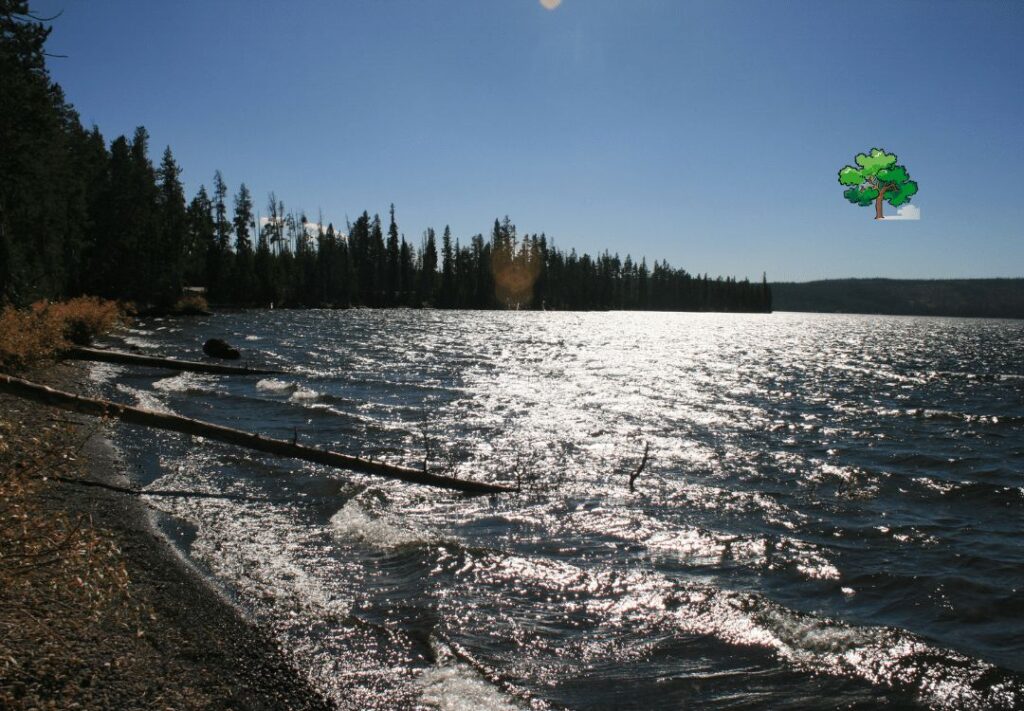
Trailhead: Lewis Lake Trailhead
The Lewis Lake trail is an easy, 3-mile round-trip hike, generally taking about 1-2 hours. The Lewis Channel Trail provides an alternate route, leading hikers to Shoshone Lake.
The unique feature of this trail is the spectacular view of the Lewis River and the serene ambience of Lewis Lake – an excellent spot for canoeing and fishing.
Activities at Lewis Lake:
Fishing: The cool waters of Lewis Lake are a haven for multiple fish species. While the lake once had no fish due to the barrier created by Lewis Falls, it now teems with brown, brook, and lake trout.
For avid anglers, the most fruitful fishing spots are near the lake’s southern outlet and where the Lewis Channel flows into the lake.
The lake sees peak fishing activity around mid-June and late October, when brown trout are especially active.
Camping: For those wishing to immerse themselves in the serene surroundings, the Lewis Lake Campground offers an ideal setting.
Positioned close to the water’s edge, this campground is a popular summer haven for visitors. Keep in mind it operates on a first-come, first-serve basis, so planning ahead is key.
Plus, there’s a handy boat ramp and fishing permits available nearby.
Kayaking and Boating: Lewis Lake welcomes all water enthusiasts. Kayak or canoe near the lake’s periphery to enjoy the stillness and gentle lapping of its waters.
For those seeking a challenge, paddling up the Lewis River towards Shoshone Lake offers a unique adventure – just be prepared for stronger currents as you go upstream.
If you prefer a motorized approach, boating is also a favored activity, though rentals are not available on-site.
Exploring Nearby:
The Lewis Channel, a picturesque 4-mile stretch, serves as the watery highway connecting Lewis Lake to Shoshone Lake.
While some adventurers prefer to motorboat across Lewis Lake to access the channel, others opt for a scenic hike along its banks.
Come October, the channel becomes a hotbed of fishing activity, as brown and lake trout migrate, providing unparalleled angling experiences.
For those curious about local regulations, Yellowstone has implemented specific fishing and conservation rules to preserve its natural wonders.
These rules encompass season timings, bait restrictions, and protected zones. Some areas remain off-limits to safeguard endangered species and to maintain the park’s pristine natural views.
Location and Accessibility:
Nestled in the southern part of Yellowstone National Park, Lewis Lake is effortlessly reachable from the South Entrance Road.
Positioned almost midway between Grant Village and the South Entrance, it’s an unmissable destination.
Best visited during late spring, summer, or fall, Lewis Lake promises an unforgettable rendezvous with nature in its purest form.
Wrangler Lake
Within Yellowstone National Park’s southern reaches, Wrangler Lake stands as a tranquil escape within the expansive Absaroka-Beartooth Wilderness.
This compact yet charming lake boasts a depth of roughly 20 feet and is nourished by streams both from its northern and southern terrains.
Aside from its scenic beauty, Wrangler Lake offers opportunities to spot diverse wildlife, including moose, bears, and other fauna native to the region.
Wildlife and Recreation: Gazing into the pristine waters or exploring the lake’s periphery, one can often glimpse the reflections of roaming moose or distant bears.
The surrounding wilderness beckons with an array of hiking trails, each promising its own unique vistas and encounters with Yellowstone’s unparalleled biodiversity.
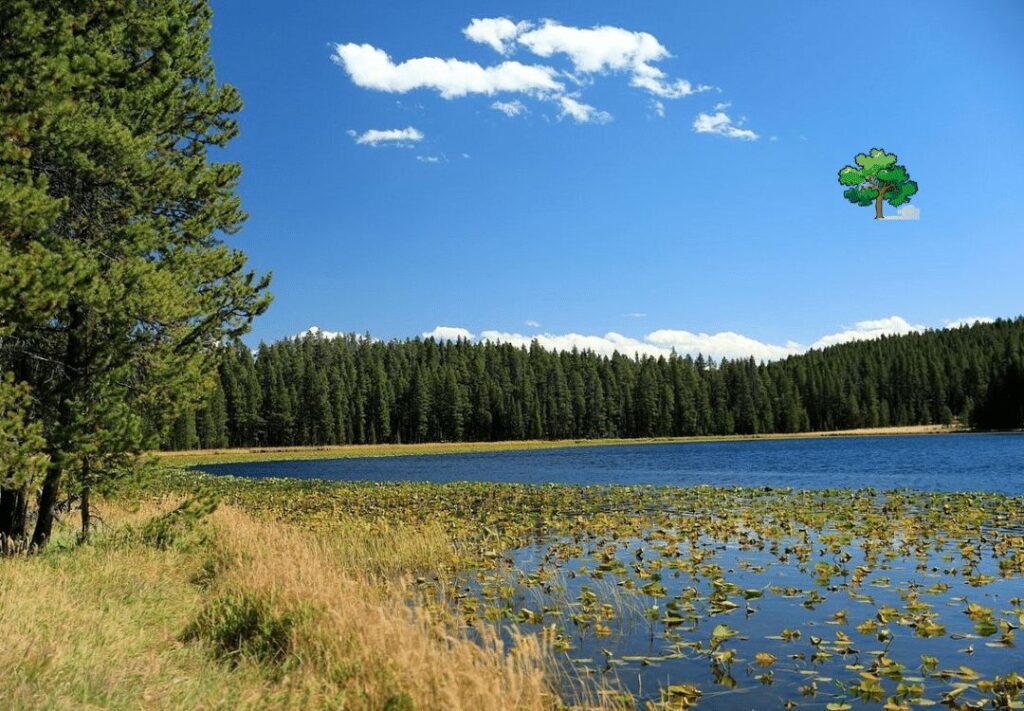
Hiking the Wrangler Lake Trail:
Difficulty: Moderate
Duration: 2.5-4 hours
Distance: 8.0 miles
Elevation Gain: 515 ft
The trail is a haven for those looking to experience Yellowstone without the bustling crowds.
While the route offers its own challenges, including stream crossings, its rewards in the form of unparalleled scenic beauty are boundless.
However, it’s advisable for families with younger children to opt for other trails due to these crossings.
Trail Highlights:
Starting from the Wapiti Lake Trailhead, adventurers will meander along the Wapiti Lake Trail, making crucial turns as described, eventually leading to the serene shores of Wrangler Lake.
As the early summer might bring in bugs, it’s essential to come prepared with bug spray or protective clothing.
For those desiring a more immersive experience, the 4W1 campsite by Wrangler Lake offers an idyllic backdrop for a night beneath the stars.
Directions to the Trailhead:
The journey begins at the Wapiti Lake Trailhead, accessible via the South Rim Drive.
Given the trail’s remote location, visitors should ensure their vehicles are well-fueled before embarking on this adventure.
Additional Trail Information:
Backcountry Campground: 4W1-Wrangler Lake
Best Time to Visit: June to September
Pets: Not permitted
Family-Friendly: Not recommended
Signage: Average quality
Crowd Levels: Typically low
Trail Type: Out and back
A Word of Caution: While Wrangler Lake offers a remote, peaceful hiking experience, visitors should be adequately prepared.
With no services available along certain stretches, it’s essential to stock up on necessary supplies, including gas, food, and water, before venturing into this wilderness.
Blacktail Ponds
Situated in the northern region of Yellowstone National Park, the Blacktail Ponds serve as a serene and often-overlooked gem, contrasting the busier attractions of the park.
The Ponds, surrounded by lush meadows and rolling hills, offer visitors an intimate glimpse into the park’s vibrant ecosystem and the opportunity to escape the bustling crowds.
Geographical Setting
Blacktail Ponds spread across the Blacktail Deer Plateau, an area renowned for its scenic beauty and diverse wildlife.
The plateau itself is a blend of verdant grasslands and dense coniferous forests, making it an ecotone, a transition area between two biomes.
The ponds are a series of interconnected water bodies, resulting from the natural collection of rainwater and snowmelt. Our favorite spot – The Blacktail Ponds Overlook!
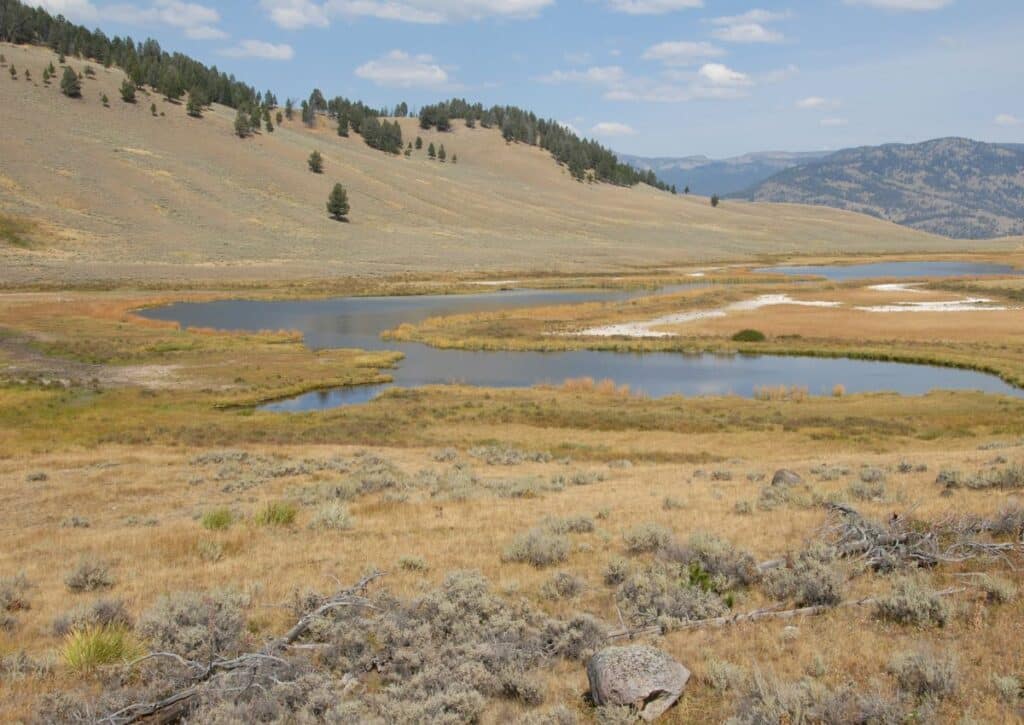
Wildlife Extravaganza
Owing to its rich biodiversity, the area surrounding Blacktail Ponds is a haven for wildlife enthusiasts.
The ponds attract a wide range of animals, from the majestic elk grazing in the meadows to the playful otters sliding into the water.
Birdwatchers can spot a variety of waterfowl, including ducks, geese, and the occasional osprey diving for a catch.
The ponds’ calm waters reflect the frequent visitors like bison, pronghorn, and, if one is lucky, a prowling coyote or wolf in the distance.
Activities and Exploration
While the Blacktail Ponds might not offer the intense adrenaline rush of some of Yellowstone’s other attractions, they provide a calm and reflective experience.
It’s a perfect spot for:
Nature Photography: With the dramatic backdrop of forests, meadows, and the wildlife, the Ponds are a photographer’s paradise.
Birdwatching: Given the diversity of avian species, it’s advisable to carry a pair of binoculars and a field guide.
Nature Walks: The area has several trails that allow visitors to explore the surroundings at a leisurely pace.
Environmental Importance
The Blacktail Ponds play a crucial role in maintaining the ecological balance of the region.
They act as a freshwater reserve for the local wildlife, especially during the drier months.
Moreover, the wetland ecosystem of the ponds supports a unique set of flora and fauna, contributing to the park’s biodiversity.
Conservation Efforts
Recognizing the significance of the Blacktail Ponds, Yellowstone National Park has put in place measures to conserve this fragile ecosystem.
Visitors are encouraged to follow the “Leave No Trace” principles, ensuring minimal human impact on the environment.
The Blacktail Ponds might not have the grandeur of Yellowstone’s geysers or the vastness of its canyons, but they offer a tranquil setting, brimming with life and natural beauty.
It’s a place where one can truly connect with nature, appreciate the smaller wonders, and understand the delicate balance that sustains our world.
Cygnet Lakes
Secluded within Yellowstone’s vast wilderness, Cygnet Lakes offer a balance of serenity and wild beauty. Smaller in size compared to some of Yellowstone’s giants, what they lack in vastness, they make up for in undisturbed charm.
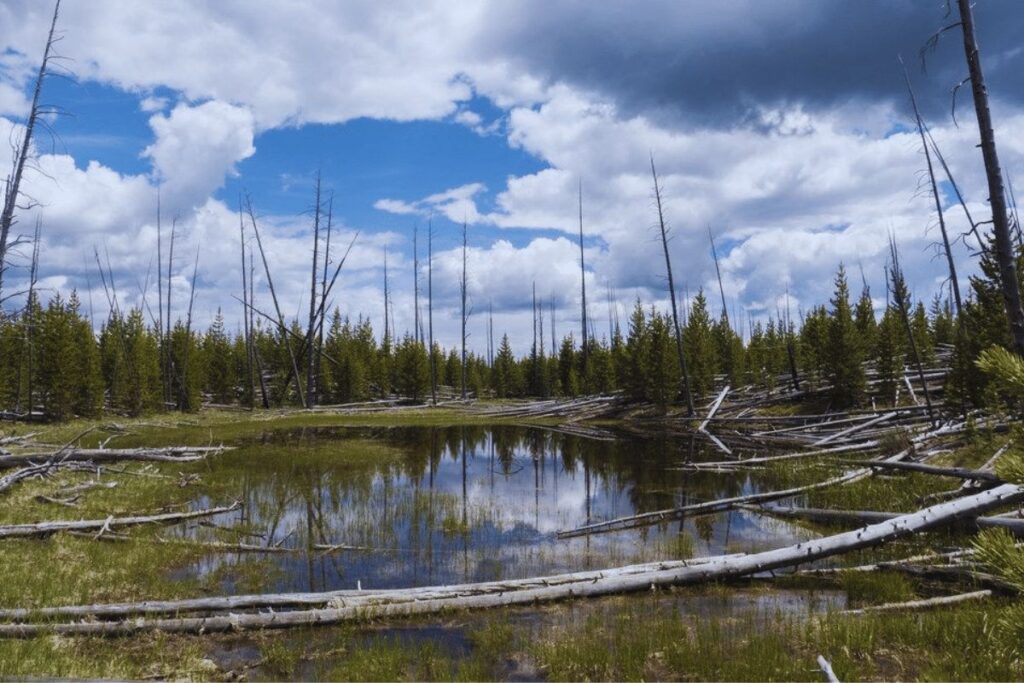
The Cygnet Lakes are surrounded by a thick canopy of forests, primarily lodgepole pines, providing a peaceful shade for visitors and a habitat for local wildlife. On a calm day, the reflective nature of the lakes mirrors the sky and trees, creating an almost surreal environment.
Flora and Fauna
The dense forests around Cygnet Lakes are rich with various wildlife. Deer, elk, and even the occasional moose can be spotted grazing around the shores.
Bird enthusiasts would delight in the sights and sounds here, as the lakes attract a diverse variety of birds, ranging from songbirds to raptors.
Trail Highlights
For those inclined towards hiking, the Cygnet Lakes Trail is the gateway to this hidden gem. The trail is a moderately challenging 5-mile round trip, weaving through dense forests and open meadows, with occasional sightings of local fauna.
Taking an average of 3 to 4 hours to complete, it’s advisable to start early in the day. Along the route, hikers are greeted with smaller ponds and vantage points, offering panoramic views of the surrounding wilderness.
Once at the lakes, a sense of tranquility envelops the traveler, making the hike both a journey and a destination.
Ice Lake
Tucked away in the cooler altitudes of Yellowstone, Ice Lake is a shimmering haven of clear, pristine waters. Its seclusion from the main trails grants it a tranquility that resonates with those looking for an undisturbed experience.
The lake’s name is derived not just from its chilly waters but also from the crystal-clear reflections it offers, especially during the early morning and late afternoon hours.
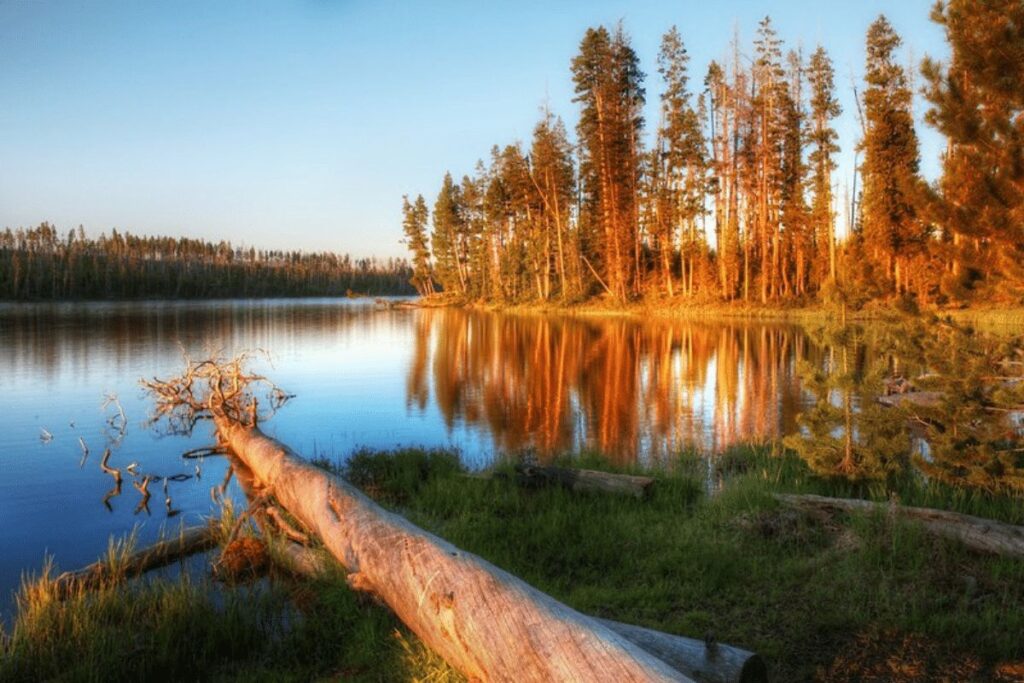
Flora and Fauna
The area around Ice Lake teems with life. Dense groves of spruce and fir trees envelop the lake, providing shelter to an array of wildlife.
It’s not uncommon for visitors to catch glimpses of marmots, pikas, and even the elusive pine marten darting between the trees.
Birdwatchers can revel in the chance to spot woodpeckers, jays, and various songbirds that make their homes in the trees around the lake.
The Trail
The hike to Ice Lake offers both challenge and reward. The trail stretches for about 4 miles round trip, taking hikers through a mix of terrains.
While the path can be steep in parts, the scenic vistas it offers are more than compensatory. Depending on one’s pace, it generally takes 2-3 hours to complete.
As you progress, you’ll navigate through dense forests, cross bubbling streams, and traverse open meadows, all culminating in the breathtaking beauty of Ice Lake.
Whether you’re a seasoned hiker or a casual nature lover, the path to Ice Lake promises a memorable journey.
LOST LAKE
Situated close to the iconic Petrified Tree, Lost Lake offers a serene backdrop that’s particularly enchanting during spring.
Surrounded by meadows ablaze with wildflowers, the lake is encircled by a 4-mile (6.4 km) loop trail that also meanders through dense woodlands and follows the tranquil shores of the lake itself.
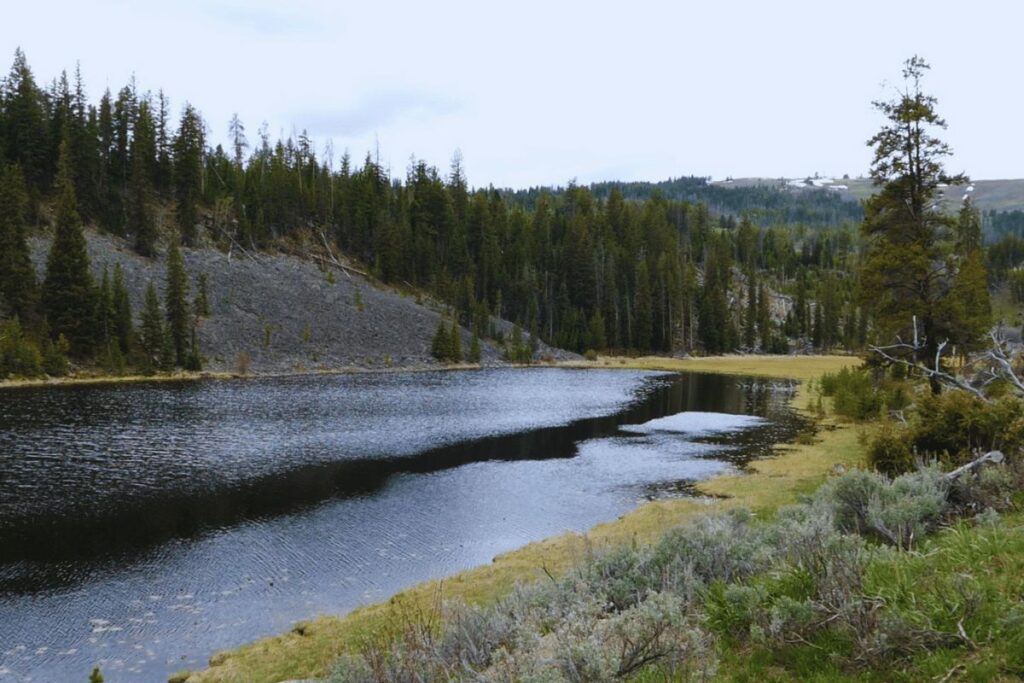
Flora and Fauna
The diverse ecosystem around Lost Lake ensures a rich tapestry of life. Beyond the burst of wildflowers in the meadows, the surrounding forests echo with the chirps of local birds and rustling wildlife.
Visitors should be vigilant and might be rewarded with the sight of bison leisurely grazing, or even the rare and exciting glimpse of a black bear or wolf prowling in the vicinity.
The Hike
The Lost Lake Loop offers a relatively relaxed hiking experience, making it ideal for families or those who prefer an unhurried exploration.
With a modest elevation gain of just 290 feet (88 meters), it provides a gentle journey that allows hikers to truly immerse themselves in the area’s natural beauty.
Whether it’s to capture the perfect photograph or simply to take a moment of pause by the lakeside, this trail promises both adventure and tranquility.
How many lakes are in Yellowstone National Park?
Yellowstone National Park is home to over 300 lakes.
Yellowstone, often celebrated for its geothermal wonders and diverse wildlife, also boasts a vast number of lakes, with a count exceeding 300. The largest and most iconic of these is Yellowstone Lake.
Spanning 132 square miles, it is North America’s largest high-altitude lake and holds over half of the park’s total water surface area.
The lake’s pristine waters, deep blue in color, can reach depths of up to 400 feet.
Beyond Yellowstone Lake, the park contains many smaller lakes and ponds, each contributing to the park’s unique ecosystems.
They serve as habitats for a variety of aquatic life, from native cutthroat trout to diverse waterfowl species.
Furthermore, these lakes play an essential role in the park’s hydrological system, feeding into numerous streams and rivers that snake through the vast landscape.
What are the major lakes in Yellowstone National Park?
The major lakes in Yellowstone National Park are Yellowstone Lake, Shoshone Lake, Heart Lake, and Lewis Lake.
Yellowstone Lake stands as the most iconic and largest body of water in the park.
With a surface area of 132 square miles, it’s not only the biggest lake in Yellowstone but also the largest high-elevation lake in North America.
The lake’s numerous arms, like the West Thumb, and its deep blue waters have become symbols of the park itself.
Shoshone Lake, although lesser-known to some visitors, holds significance as the second-largest lake in the park and is the largest lake in the contiguous U.S. without a road leading to its shores, making it a remote gem for backcountry enthusiasts.
Heart Lake, tucked away near Mount Sheridan, draws hikers and backpackers with its breathtaking views and serene setting.
The lake gets its name from its heart-like shape, though some tales trace its naming to a hunter from the 1840s.
Lewis Lake is another prominent water body located near the park’s southern boundary.
While smaller compared to the other major lakes, its accessibility and picturesque surroundings make it a popular spot for fishing and boating.
Together, these major lakes define some of Yellowstone’s most captivating landscapes and offer unique opportunities for exploration and recreation.
Can you swim in the lakes at Yellowstone National Park?
Yes, you can swim in the lakes at Yellowstone National Park, but there are several important considerations:
Temperature: The lakes in Yellowstone are often quite cold, even in summer.
Yellowstone Lake, for instance, has an average water temperature of around 41°F (5°C) even in July. Some smaller lakes might be a bit warmer, but the cold can still be a shock to the system.
Currents and Underwater Hazards: Some lakes have unpredictable currents, and there may be hidden underwater hazards like logs or rocks.
Thermal Features: There are many thermal areas in Yellowstone. Swimming in hot springs or any thermal feature is prohibited due to the risk of scalding and the potential for the thin crust near these features to break.
Wildlife: Lakes can be frequented by animals like bears and moose. Always be cautious and aware of your surroundings. Additionally, avoid swimming in areas where waterfowl are nesting.
Regulations: While there’s no park-wide ban on swimming, some individual lakes or areas within them might have restrictions. Always check with a ranger or look for posted signs.
Altitude: Yellowstone’s elevation can amplify the risks associated with swimming, including hypothermia. The park’s average elevation is about 8,000 feet, so the water in lakes and rivers remains cold throughout the year.
Many visitors opt to swim at the Boiling River near Mammoth or the Firehole River swim area, where warmer thermal waters mix with cold river water, providing a more comfortable swimming experience.
However, even these popular spots can have swift currents and cold sections. Always exercise caution and be aware of your own limits.
What is the Yellowstone Lake called?
The primary and largest lake in Yellowstone National Park is called Yellowstone Lake.
This majestic body of water is not only the largest high-altitude lake in North America but also a significant landmark within the park.
Spanning approximately 136 square miles (352 square kilometers) and reaching depths of up to 400 feet (120 meters).
Yellowstone Lake is a picturesque destination characterized by its clear blue waters, surrounded by forested mountains and punctuated by its very own Lake Yellowstone Hotel, a historic structure built in the late 19th century.
Why can’t you swim in hot springs at Yellowstone?
Swimming in hot springs at Yellowstone is prohibited for several reasons:
Safety Concerns: Many hot springs in Yellowstone are at or near boiling temperatures, posing a severe scalding risk.
Delicate Environment: The hot springs host unique and fragile microbial life that can be disturbed or destroyed by human contact.
These microorganisms often create vibrant, colorful displays that are easily disrupted.
Thin Crust: The ground around many thermal features, including hot springs, is a thin crust that can break easily.
Underneath this crust is boiling water, making it treacherous for anyone stepping off designated boardwalks or paths.
Can you swim in any hot springs in Yellowstone?
No, you cannot swim in the hot springs within Yellowstone National Park.
However, there are designated areas like the Boiling River and the Firehole River swim area where hot spring water mixes with cold river water, creating a more suitable environment for swimming.
Even in these areas, visitors should be cautious of changing conditions and always adhere to posted rules and guidelines.
Can you touch Yellowstone water?
Yes, you can touch the water in Yellowstone in non-thermal areas, such as lakes and rivers.
Yellowstone Lake, for example, is a popular spot for recreational activities like fishing.
However, when it comes to thermal features, including hot springs, geysers, and fumaroles, it’s crucial not to touch the water or venture off designated paths and boardwalks.
The water in these areas can be extremely hot and acidic, and the ground can be unstable. For safety and preservation reasons, always respect park regulations and signage.
Conclusion
The sheer beauty of Yellowstone is hard to describe, which is why we’ve done our best to demonstrate it with these incredible photos. We hope that they’ve done at least a little bit of justice to this fantastic place.
If you’re ever in the area, it’s definitely worth adding Yellowstone National Park to your to-do list. It doesn’t matter if you’re planning an extensive trip or just a short camping excursion – once you’ve set foot in Yellowstone you’ll almost certainly want to come back for more adventure.
